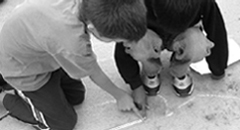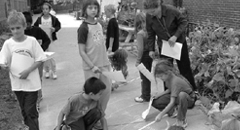
|

|

|
PROPOSITION I. Factors that influence the formation, functioning, and demonstration of understanding of learning groups in early childhood include the size of the group; the age, competencies, and interests of the children; gender; time spent together; friendships; and choice of materials.
PROPOSITION II. Individuals within a learning group have their own approaches to learning, which can nonetheless be influenced by the learning approaches of others. We refer to this phenomenon as the "modifiable fingerprint."
PROPOSITION III. When exploring ideas together, learning groups follow a set of rules—some tacit, some explicit.
PROPOSITION IV. Learning groups choose ideas according to an aesthetic of knowledge or "the pattern that connects."*
PROPOSITION V. Learning groups have different styles that are rhythmic in nature.
PROPOSITION IV. Learning groups can create and benefit from competent audiences.
PROPOSITION VII: Indicators that learning groups are supporting and demonstrating understanding include the following:
a. Children and adults feel they are contributing to a larger, more meaningful whole.
b. The discoveries of individual children become part of the thinking of the learning group.
c. Children express a feeling of continuous growth and awareness that their theories are provisional, and they take pleasure in seeing them modified, developed, and advanced.**
d. Over time the members of the learning group, alone or as a group, verify, consolidate, and apply concepts and competencies acquired in one context to other contexts and domains of knowledge.
e. Children and adults use a language of thinking and emotion.
f. The objective that the group sets for itself is reached by keeping together the procedural and content requirements of the work.
g. Assessment and self-assessment have a strong presence inside the learning group and serve to guide and orient the learning process.
h. Collaboration strategies are an integral part of the group learning process and can determine the quality of learning.
* By aesthetics, the Reggio educators refer to the ability to the ability to judge and evaluate images or theories that work best for the particular project at hand. They also use the term to imply what is most pleasing, attractive, or satisfying to oneself or to others.
** We use the term theory to refer to a "system of concepts, strategies, and actions that provides a satisfactory explanation for the person who produces the theory." (Rinaldi, 1999) Although theories are characterized by the coherence and interdependence of their concepts, they are not static but open to falsification by new evidence.
© 2001 Project Zero and Reggio Children, p.247.
To view documentation examples from Reggio Emilia please visit:
The City of Reggio
Ring-Around-The-Rosy
[Home] [Site Map]